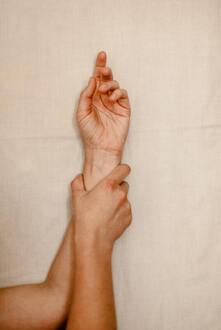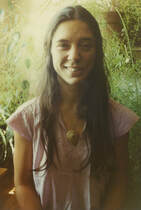 Becoming a song writer influenced the way I worked with my client’s bodies. I began to use metaphor as a ‘language’ to help them express the sensations and emotions they were feeling in their body: ‘my arm feels like a weakened branch about to break’. These metaphors also gave me a head start on being able to treat their tensions as I had more information about how they were experiencing their symptoms of discomfort. I rarely fed them metaphors because I found that the ones they came up with were more powerful---remembered for a long time. Once they found the metaphor that would acknowledge their pain accurately, we would move on to transform it (no one wants to keep a shattered stick in their arm) by guiding them on metaphoric narratives that became like their own parables for living more comfortably: “I will create a special tube going from the earth through my trunk and suck up some golden earth liquid into my arm where it will create a healing spiral. This spiral will gently whirl through all the cells in my arm and let them know they are wanted and can be strong again” These metaphoric journeys have become a hallmark of the Magraw Method Havening Techniques® which I am now offering as one of my services (online with clients from all over the world) also works with words and touch. The use of questions and sensory descriptions helps to shift internal landscapes and increase emotional calmness at the same time changing the wiring of trauma in the brain. Words are used for acknowledging the negative states and choosing the preferred states—often done in a chanting mode---transmuting stuck energy, thoughts and emotions. Combined with the Havening Touch®, words become effective sensory and transformational tools. We feel able to tell our ‘story’ and know that we are being heard because of the soothing touch. Wisdom codes is a term used by Gregg Braden, who wrote a book of the same title, about words that have been around for centuries---prayers, sayings, parables---that communicate comfort in times of trouble. I, like many others have found historical ‘codes’ that calm my nervous system and then written my own in the form of songs. When we use our singing voice it strengthens the vagus nerve system which allows a calmer state. We are then able to put brakes on the run-away ‘fight or flight’ states and think our way out of bad situations. I would encourage you to experiment with words in your body; spoken, chanted or sung. They have the power to help you. Resources: The Wisdom Codes: Ancient Words to Rewire our Brains and Heal our Hearts by Gregg Braden. Article on Havening®
1 Comment
 I remember when I first turned to self massage: it was early in my career when I was attending massage school and working full time. I often arrived at class exhausted and frequently was bored having already studied the course material for my U.S. massage license. So how did I keep myself awake? I would find a sore spot where I could reach---often on arms, shoulders, ribs---and with my fingers, press, rotate and listen. Was the spot releasing? Did I get a warm feeling? I would guess which organ the trigger point might be connected to--I knew the acupuncture meridians by then. Time would fly by. I would feel better and know my body better. This self massage practice continued for many years. It gave me comfort but also power, sometimes the power to heal and sometimes the information needed to give a doctor or other practitioner so they could help me. Fastforward to 2020 and the pandemic. None of the practitioners I normally go to are working. Stress levels are high, in the world and in my body. I know I need to help my body stay healthy but there is so much to do and so much new technology to learn! First I was in ‘ignore mode’, until my back called loudly in the language of pain. I began to release my Psoas muscle (see Techniques for keeping the body in mind at the end of chapter 9). I did active release using a ball on my back and buttock muscles. I congratulated my body in its letting go process. Gradually the pain and stiffness receded and I realized that I had been sitting in a twisted position at the computer while feeling tense. No more of that! Next I began to get the symptoms of an ear infection---a familiar event due to my unusual anatomy because of the Microtia in my left ear. I began to massage the reflex points, meridians, and immune system points. But the infection had gotten ahead of me. I realized I had to use the antibiotic drops-- they worked. With my hands on my chest I forgave my body for not being able to let go of the infection with just the help of my hands. My mind calmed, as it registered the love inherent in self forgiveness and the understanding that comes with it. I realized that the pollen in the air plus the stress of isolation had been too much. I needed external help this time. Knowing when we can heal ourselves and when we need help comes with self knowledge. Doing massage on oneself is a great way to gain self knowledge of our body. Give your body a hand up. Start simple and progress. Do what feels good. In the technique sections of Note by Note you will find some detailed instructions on how to begin touching your body in a healing way.  During the Pandemic when we all were in lockdown, I was separated by an ocean and locked borders from the man I love, separated by the continent from my family and by the rules of Covid safety from my friends. I was suffering from isolation PTSD. As I have often done, I wrote a song to comfort and inspire myself. In my first blog on my author’s website I thought I would deconstruct the lyric to reveal how it worked for me. Verse 1 If I can smile when the world’s upside down And land on my feet safe and sound Rest in the space between each of my thoughts and see Stars smiling back at me, Stars smiling back at me The act and the metaphor of a smile has been important to me because in my operation when I was 9, I lost my smile (physically and emotionally), which was devastating and took me years to recover from. So the phrase if ‘I can smile’ means I am fighting against the pull of PTSD. When my environment suddenly changes, as it did in my body during the medical accident and as it did during lockdown, this idea of ‘smile’ helped me ‘be in the present’, remember my values and ground in them. One of my values is to be calm enough in my body so that I can notice and resonate with the beauty in my environment and in the people I see. To be able to ‘rest’ when there is high anxiety, in me and around me, is one of my triumphs against PTSD and one of the things I offer to others. This triumph has given me a path to a sense of perspective which is represented by the image of stars in the lyric. Verse 2 If I can smile when the dark clouds are chasing And fly as if my heart had wings Transparent love and a hummingbird’s mind Will carry me into the light, will carry me into the light Many survivors of trauma fall into depression at various times in their lives and I am no exception—the dark clouds do chase me. One of my remedies for that is self love manifested in movement--everything from walking to dancing. This has allowed my body state (and identity) to steer clear of being ‘a depressed person’ and instead feel my ability to lift my heart into ‘flight’. What does ‘transparent love’ mean? To me it means love that is admitted, spoken and displayed even in the face of disappointment. To learn from each experience of daring to love will carry me forwards into a better place--represented by the image of light. And what is the significance of a ‘hummingbird’s mind’? Hummingbirds have very large brains for their size and this enables their sophisticated system of moving about the world. They can fly in all directions, hover and fly long distances. This is a metaphor for flexibility-- what is now called neuroplasticity. The idea that our choices will ‘carry’ us helped me to focus away from excessive effort during the pandemic and instead focus on careful choices. Verse 3 If I can smile when the battles are raging And finding some peace seems amazing Strong as the river and calm as a lake This peace I will never forsake, this peace I will never forsake First let me give you my definition of peace. Most importantly, it includes the principles of truth telling and change. ‘Strong as a river’ is an image that implies there is something to be strong for: and that is revealing one’s pain and protesting the injustice that often goes with telling one’s truth. But what is the ‘truth’? In my definition it is ideas and actions that benefit society—that make things better for individuals and communities—it is what ‘works’ to promote health, connection and fairness. It is so important these days to find the truths that will help with the Black Lives Matter movement and will help with the necessity of facing the poisons of prejudice, war and dictatorship. I have had to face my old demons during this time of enforced solitude, tell the truth about them and gain that ‘river strength’. The vagus nerve system is a huge system in the body that regulates our bodies and minds bringing us back to a feeling of safety. The phrase ‘calm as a lake’ is expressive of the body/mind state of a healthy vagus nerve--- of renewal and re-connection. I found I needed to commit to and practice this state which I call peace. Change happens best using a combination of truth and peace. Actions of truth and peace produce change. I am counting on the idea that many people in the world are having these same thoughts so that now we can find new ways to move forward. I invite you to write your own words of meaning, as a poem or a song, memorize them and then repeat it often. It could help you find your way. |
AuthorKristi Magraw is known for having developed a unique synthesis of Eastern healing (Five Element theory) and Western ways of working with the mind, called the Magraw Method, which she established in 1979. This method uses metaphoric language and release techniques to help people heal physical and emotional pain. Archives
September 2023
Categories |
 RSS Feed
RSS Feed
